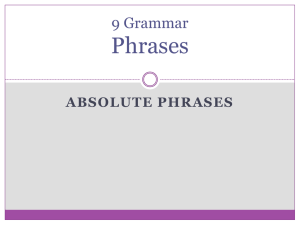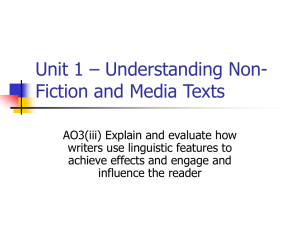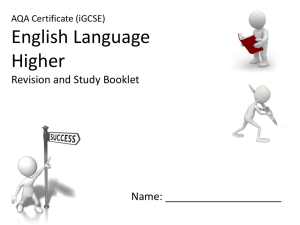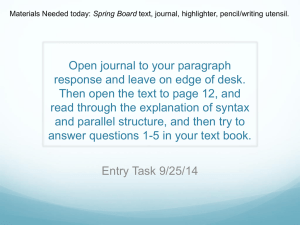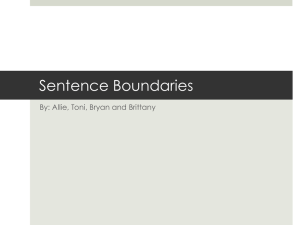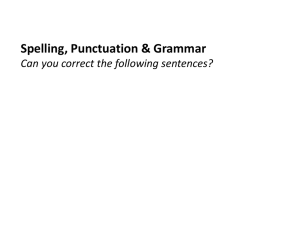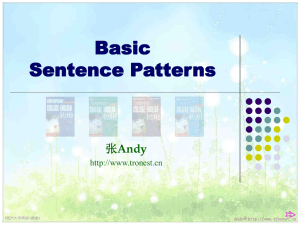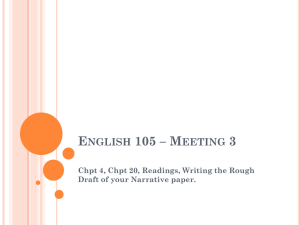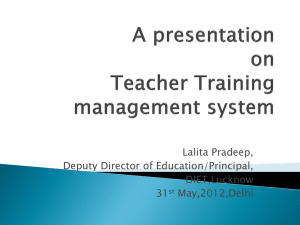Writer`s Notebook PowerPoint
advertisement
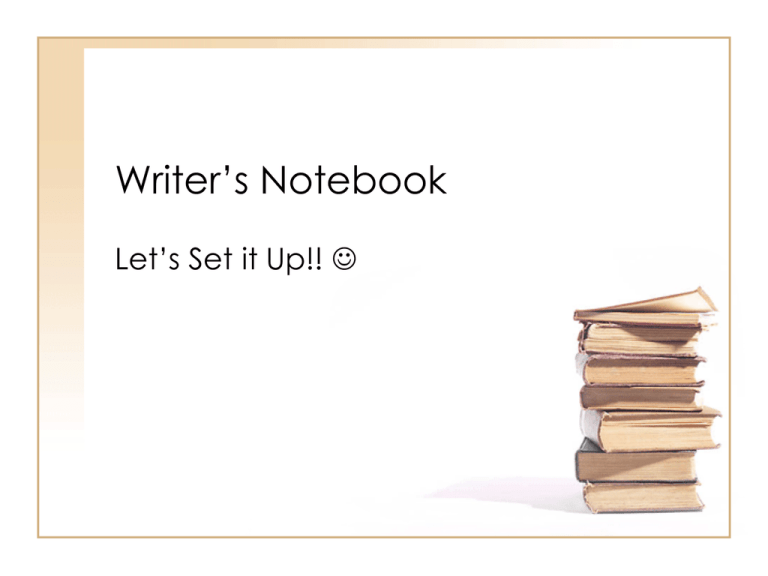
Writer’s Notebook Let’s Set it Up!! Notebook Set Up • 1. Never tear out a page of your notebook. Never. • 2. Leave a fly page up front, just like in books. • 3. Number pages only on the righthand side, starting after the fly page. • 4. Write the page # on the bottom right-hand side. • 5. Only write on the right-hand pages of the notebook. The left-hand side pages are for revising, rethinking, and tinkering with the facing numbered page. Numbering… • 4 Sections • On each Post-It Note (opposite of the sticky side) write…. • -Writing (pgs. 1-70) • -The Writer’s Eye (I) (pgs. 7175) • -Author’s Word and Phrase Palette (pgs. 76-85) • -Gems (pgs. 86-100) “Writing” Section • Always date each entry and give it at least a oneword title • You will free-write, respond, pre-write, create, shape take notes, glue materials from our quick daily writer’s secret work and play with their writing here. In Writing with Power by Peter Elbow….. • “Frequent free writing exercises help you learn to simply get on with it and not be held back by worries about whether these words are good words or right words” Free writing Class Lesson • Autobiography of a Face by Lucy Grealy (1994), pg. 31-32 (MI) • What words or phrases stuck with you? • Free-writing will be an important part of our writing this year. • “Just Write. Go wherever the writing takes you.” Free-writing Rules!! 1. Write. Just write. Keep your hand moving. (The only way to do free-writing wrong is to not write or to quit early). 2. Experiment with spelling, punctuation, and grammar. 3. Go wherever your writing takes you. If another story comes to mind, maybe that’s what you should be writing about. Go for it! 4. Be specific. 5. As Natalie Goldberg says, “You are free to write the worst junk in America” (1998) Write “Bullying” at the top of your page… • Skip a line and write about something you’ve done, experienced or have seen happen. • Start with the idea of bullying and go where the writing takes you. • Try to add specific details. Bedhead MI (pgs. 32-35) • Let’s read aloud Bedhead • Open Writer’s Notebooks and put today’s date and write Hair across the top. • “Wherever the writing takes you, go with it. Just keep writing. The key word is hair. “ • Let’s share. Bedhead Excerpt • “Shuffle-shlump. Shuffle-shlump. • Shuffle-shlump, • Shlumped bleary-eyed Oliver out of bed, down the hall, and into the bathroom. • He yawned. He yanked. Splashed some water. Swished some mouthwash. • Gave his front teeth a passable brushing. • And then… • In a gunkless corner of the soapy silver soap dish…” What is … called? • An Ellipse! • What does an ellipse do in this passage? • Did you notice the short sentences and fragments? • They fly off our tongue. • Did you notice the long sentences? • They roll around giving us a feel for the action. Let’s play around with our freewrite • Try to imitate any of Palatini’s punctuation or conventions • It’s midnight. I’m nervous, and my eyebrows suddenly look way too bushy. • I pluck. No, that’s not going to be fast enough. I reach for the scissors. No. I can’t hold them that way and still cut. But then I see them… the clippers. • Sure I have to look great to present in front of 400 teachers and the only thing standing between me and perfection are my….BUSY BROWS. • Buzz. Yes. Buzz. Yes. Buzz. Oops. No more buzz. No more middle in my left eyebrow. I stare in the mirror: one bushy brow and one half-n-half brow. Your Free-writes…. • Play around with the punctuation in new ways. • Take risks. • Be bold. • We can always play with it more. Go! • Let’s share. The Writer’s Eye (I): List of Things I can Write About (MI: pgs. 35-37) • 1. In this section write about the life you’ve observed with your own eyes. • 2. Start a collection of the people, places, games, hobbies, interests, and so forth that you know well. The Writer’s Eye (I) • You have two choices on how to decorate this page with words. • I will draw them both on the board “When I Was Little” by Jamie Lee Curtis (MI: pgs 37-39) • Let’s read it aloud. • Take out your writer’s notebooks and turn to the “Writer’s Eye” section. On the first page after your first Writer’s Eye (I) list, write the date and then skip a line and write “When I was Little List”. (A list of memories) • Now share your list with someone near you. (5 min.) • Add more (3 min.) • Commas and periods at the end. Go! (3 min.) • Draw lines to the connected items. • Circle 1 sentence or a group of connected sentences. • Free-write! (in the next clean page in “Writing” section) Why do we use a comma after “When I was little, “? • The comma told me to pause. • “There are several words that, when they are located at the beginning of a sentence, signal you to use a comma to separate the introductory phrase from the rest of the sentence. They are comma causers.” AAA-WWU-BBIS • • • • • • • • • • As Although After While When Unless Because Before If Since AAAWWUBBIS • If you stat a sentence with an AAAWWUBBIS, you are almost guaranteed to have a comma in the sentence. • Reminder: The comma never immediately follows the AAAWWUBBIS. • Let’s practice with a sentence using an AAAWWUBBIS. Author’s Word and Phrase Palette • This will be a “collection”. • You will record words or phrases that “strike you” for different reasons. • Words have POWER!!! • You can create a piece of writing using the palette. You can also use the palette to help you with word choice. Author’s Word and Phrase Palette • What type of words should I collect? • Active Verbs: Writing snaps and sizzles when active, lively verbs are used. • I.E. “skitter” and “crackle” • “Cool” words • Phrases or combinations that work. (Like alliteration or phrases that “dance” on the page • Contrasts/comparisons: similes, metaphors, sensory images and others. Look for something fresh! • “Her open eye was like nearly black balsamic vinegar beading on white china. “ Author’s Word and Phrase Palette • We might categorize words.. • • • • • • • Awesome Adjectives Frigid Meaty Affluent Grainy Sprawling house Paper-thin layer of muscle Gems: Sentences and Paragraphs that Work • Gems are always full sentences or MORE! • Instead of just words or phrases, hunt down sentences, string of sentences and paragraphs that work! More on gems…. • “These sentences should make the reader stop, bend over, pick up the gem and see it sparkle in the light.” • In your Gems section please dedicate 3 pages for the following: • 1 page “Introductory Phrases” • 1 page “Sentences with interrupting phrases” • 1 page “Closing Phrases” What if my sentence fits into more than one category? • That’s great! Just write the sentence in both categories and highlight the section that makes it fit. • I will be giving you some inserts to glue into your notebooks as we go through the lessons. Editor’s Checklist • We are getting ready for Middle School so let’s learn some “writer’s secrets” • Why do we have punctuation? Or better yet, why do we have laws and rules everywhere we go? (5 min.) Editor’s Checklist • Who do you think invented conventions or rules for writing? • It was writers! They wanted to be understood. Don’t you want to be understood too? • Grammar and mechanics are conventions. Conventions • Convention meant agreement in its original Latin form. • Writer’s wanted people to understand what they said, even when they weren’t around. • A period means stop this thought; a capital letter signals that a new sentence is beginning or that a word is a name. Power of conventions! • “Are you tired of nobody hearing you? Writing gives you that power, and part of writing’s power is in its passion, its details, but all of that is lost if the grammar and mechanics can’t hold the message together.” “Punctuation Takes a Vacation” • Let’s enjoy the book!


